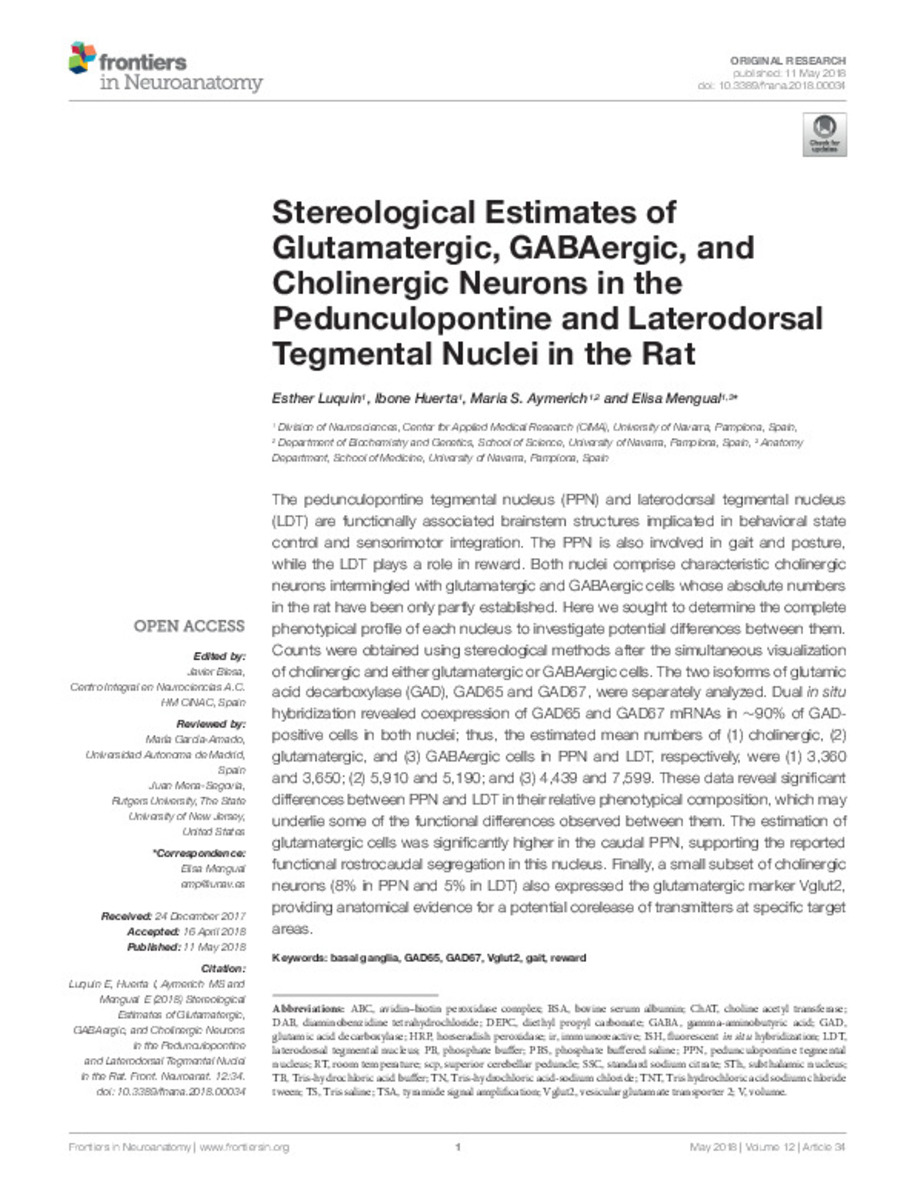Full metadata record
| DC Field | Value | Language |
|---|---|---|
| dc.creator | Luquin, E. (Esther) | - |
| dc.creator | Huerta, I. (Ibone) | - |
| dc.creator | Aymerich, M.S. (María S.) | - |
| dc.creator | Mengual, E. (Elisa) | - |
| dc.date.accessioned | 2023-03-01T12:55:37Z | - |
| dc.date.available | 2023-03-01T12:55:37Z | - |
| dc.date.issued | 2018 | - |
| dc.identifier.citation | Luquin, E. (Esther); Huerta, I. (Ibone); Aymerich, M.S. (María S.); et al. "Stereological estimates of glutamatergic, GABAergic, and cholinergic neurons in the pedunculopontine and laterodorsa tegmental nuclei in the rat". Frontiers in neuroanatomy. 12, 2018, 34 | es |
| dc.identifier.issn | 1662-5129 | - |
| dc.identifier.uri | https://hdl.handle.net/10171/65599 | - |
| dc.description.abstract | The pedunculopontine tegmental nucleus (PPN) and laterodorsal tegmental nucleus (LDT) are functionally associated brainstem structures implicated in behavioral state control and sensorimotor integration. The PPN is also involved in gait and posture, while the LDT plays a role in reward. Both nuclei comprise characteristic cholinergic neurons intermingled with glutamatergic and GABAergic cells whose absolute numbers in the rat have been only partly established. Here we sought to determine the complete phenotypical profile of each nucleus to investigate potential differences between them. Counts were obtained using stereological methods after the simultaneous visualization of cholinergic and either glutamatergic or GABAergic cells. The two isoforms of glutamic acid decarboxylase (GAD), GAD65 and GAD67, were separately analyzed. Dual in situ hybridization revealed coexpression of GAD65 and GAD67 mRNAs in ∼90% of GAD-positive cells in both nuclei; thus, the estimated mean numbers of (1) cholinergic, (2) glutamatergic, and (3) GABAergic cells in PPN and LDT, respectively, were (1) 3,360 and 3,650; (2) 5,910 and 5,190; and (3) 4,439 and 7,599. These data reveal significant differences between PPN and LDT in their relative phenotypical composition, which may underlie some of the functional differences observed between them. The estimation of glutamatergic cells was significantly higher in the caudal PPN, supporting the reported functional rostrocaudal segregation in this nucleus. Finally, a small subset of cholinergic neurons (8% in PPN and 5% in LDT) also expressed the glutamatergic marker Vglut2, providing anatomical evidence for a potential corelease of transmitters at specific target areas. | es_ES |
| dc.description.sponsorship | The present work was funded by Gobierno de Navarra, Departamento de Salud (Proyecto 10/2009), and Plan de Investigación de la Universidad de Navarra (PIUNA 2012-13). | es_ES |
| dc.language.iso | eng | es_ES |
| dc.publisher | Frontiers Media | es_ES |
| dc.rights | info:eu-repo/semantics/openAccess | es_ES |
| dc.subject | GAD65 | es_ES |
| dc.subject | GAD67 | es_ES |
| dc.subject | Vglut2 | es_ES |
| dc.subject | Basal ganglia | es_ES |
| dc.subject | Gait | es_ES |
| dc.subject | Reward | es_ES |
| dc.title | Stereological estimates of glutamatergic, GABAergic, and cholinergic neurons in the pedunculopontine and laterodorsa tegmental nuclei in the rat | es_ES |
| dc.type | info:eu-repo/semantics/article | es_ES |
| dc.description.note | This is an open-access article distributed under the terms of the Creative Commons Attribution License (CC BY). The use, distribution or reproduction in other forums is permitted, provided the original author(s) and the copyright owner are credited and that the original publication in this journal is cited, in accordance with accepted academic practice. No use, distribution or reproduction is permitted which does not comply with these terms. | es_ES |
| dc.identifier.doi | 10.3389/fnana.2018.00034 | - |
| dadun.citation.publicationName | Frontiers in neuroanatomy | es_ES |
| dadun.citation.startingPage | 34 | es_ES |
| dadun.citation.volume | 12 | es_ES |
Files in This Item:
Statistics and impact
Items in Dadun are protected by copyright, with all rights reserved, unless otherwise indicated.






